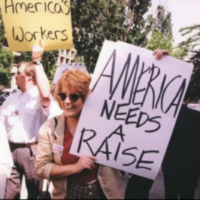Six years ago, on November 29, 2012, a small group of fast-food workers in New York launched one of the most successful movements of the 21st century when they walked off their jobs and demanded $15 an hour and the right to form a union. Since then, the worker-led movement known as the Fight for $15 has inspired a wave of action on the minimum wage, helping 22 million low-wage workers throughout the country win $68 billion in raises to date. Thanks to the movement, income inequality and flagging paychecks are now among the most urgent economic issues of our time, and a $15 minimum wage is now a widely accepted benchmark. It is a key part of the platform of one of the major political parties,[1] and lawmakers are planning to reintroduce a $15 federal minimum wage bill in the first week of the 116th Congress.[2]
Main Findings
In this brief, we update our 2016 report, which quantified the scale of the higher wages that the Fight for $15 movement helped deliver.[3] We find the following:
- Since 2012, 22 million low-wage workers have won $68 billion in annual raises (Table 1) through a combination of state and local minimum wage increases (Tables 4 and 5) together with action by employers to raise their companies’ minimum pay scales (Table 6). This figure (expressed in constant 2018 dollars) represents the total additional annual income that workers will receive after these approved increases fully phase in.[i]
- To put these wage gains in context, this $68 billion raise delivered by the worker-led Fight for $15 is more than 14 times larger than the total raise under the last federal minimum wage increase, approved in 2007.[4]
- Of the $68 billion in additional income, the overwhelming share (70 percent, or $47 billion) is the result of $15 minimum wage laws that the Fight for $15 won in California, New York, Massachusetts, Flagstaff, Los Angeles, San Jose, San Francisco, the District of Columbia, Montgomery County, the Twin Cities, Seattle, and SeaTac over the past few years (Table 2).
- A total of 22 million workers throughout the nation will get raises from the minimum wage increases sparked by the Fight for $15.
- The total would have included raises for an additional 119,500 workers in Alabama, Iowa, Florida, Kentucky, and Missouri, where cities raised the minimum wage. However, legislatures in those states blocked raises for their constituents by adopting corporate-backed “preemption” laws that bar cities from raising their minimum wage. (Table 3).
DOWNLOAD FULL PUBLICATION, INCLUDING ALL TABLES, BELOW.
[i] The 22 million figure includes public sector workers (see Table 1). However, the $68 billion figure does not include wage increases for public sector workers—estimates for which are not available.
[1] Alex Seitz-Wald, “Democrats Add $15 Minimum Wage to Platform,” NBC News, July 8, 2016, https://www.nbcnews.com/politics/2016-election/democrats-add-15-minimum-wage-platform-n606351.
[2] Jake Johnson, “’We Have Got to End Starvation Wages’: Bernie Sanders to Re-Introduce $15 Minimum Wage Bill in First Week of New Congress,” Common Dreams, November 12, 2018, https://www.commondreams.org/news/2018/11/12/we-have-got-end-starvation-wages-bernie-sanders-introduce-15-minimum-wage-bill-first.
[3] National Employment Law Project, Fight for $15: Four Years, $62 Billion, December 2016, https://www.nelp.org/wp-content/uploads/Fight-for-15-Four-Years-62-Billion-in-Raises.pdf.
[4] In 2007, Congress approved raising the federal minimum wage from $5.15 to $7.25 in three 70-cent steps in 2007, 2008 and 2009. The total wage impact of the third and final step was estimated at $1.6 billion annually. See Kai Filion, Fact Sheet For 2009 Minimum Wage Increase: Minimum Wage Issue Guide, Economic Policy Institute, updated July 21, 2009, http://www.epi.org/publication/mwig_fact_sheet/. While estimates of the total wage impact for the first two 70-cent steps were not available, those impacts would be no larger than $1.6 billion, as affected workers were disproportionately clustered closer to the $7.25 wage level. Thus, we estimate the total wage impact of the three steps at approximately $4.8 billion (three times the impact of the final step). The $68 billion total wage impact of minimum wage increases since November 2012 is therefore more than 14 times the impact of the 2007 federal minimum wage increase.




